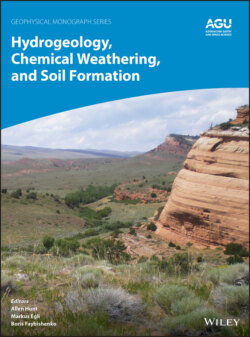Читать книгу Hydrogeology, Chemical Weathering, and Soil Formation - Allen Hunt - Страница 25
1.4.1. Soil Profiles
ОглавлениеAs explained above, Simonson (1959) suggested the concept of the soil profile as an open system. Quantitative models of soil profile development followed. An example was the CENTURY model used to simulate the formation of soil organic matter (Parton et al., 1987). It established statistical relationships between production and decomposition rates of soil organic matter and four driving variables (annual precipitation, temperature controls on decomposition, soil texture, and plant lignin content) and then predicted soil carbon and nitrogen levels for 24 grassland locations in the Great Plains of the USA. Donald Sasscer and his colleagues (1971) built a deterministic model to study stable and titrated water through an old‐field system in Argonne, Illinois; the system consisted of a vegetation compartment and 49 soil compartments, each 1 cm thick. Jerry Kline (1973) used the same basic model to investigate soil–plant relationships and soil genesis.
Donald Lee Johnson (1985) devised an evolutionary model of profile pedogenesis that considered soil thickness changes:
where T is soil thickness, D is profile deepening, U is soil upbuilding, and R is soil removal. An important feature of this model, and what makes it “evolutionary,” is that soil thickness is dynamic and may ebb or flow over time. This model formed the basis of Johnson and Watson‐Stegner’s (1987) comprehensive soil evolution model, which suggested that phenomena such as erosion, deposition, and pedoturbation can influence the soil formation processes. The model posited that soils may evolve along either progressive or regressive pathways:
where S is soil; P is progressive pedogenesis and includes processes, factors, and conditions that promote differentiated profiles; and R is retrogressive pedogenesis and includes processes, factors, and conditions that promote simplified profiles. This model was an attempt to allow for the fact that soil evolves in an ever‐changing environment so that polygenetic soils are the norm. Its keynote is polygenesis and stands in antithesis to monogenetic models and notions of zonal soils, normal soils, and climax soils.
Johnson and his colleagues (1990) developed a related evolutionary model. In summary, it assumed that
where s is a soil property or the degree of pedogenesis, D is a set of dynamic vectors and dD/dt their rate of change through time, P is a set of passive vectors and dP/dt their rate of change through time. The dynamic vectors include energy fluxes, mass fluxes, the frequency of wetting and drying events, organisms, and pedoturbation. The passive vectors include parent material, the chemical environment of the soil, permanently low water tables, the stability of slopes, and pedogenetic accessions such as fragipans, natric horizons, and histic horizons.
Jonathan D. Phillips (1993a) explored the idea of progressive–regressive pedogenic changes in his own numerical model that incorporated relative rates of progressive and retrogressive pedogenesis and feedbacks between the rate and the degree of soil development:
where s is soil development (degree of pedogenic alternation and profile organization), P is progressive pathways, and R is regressive pathways. The time differentials of P and R are defined as follows:
where c1 is the maximum rate of progressive pedogenesis and k1 a coefficient describing the decrease in P rates as soil develops; c2 is the maximum rate of regressive pedogenesis and k2 a coefficient describing the decrease in R rates as soil develops (negligible). Phillips’s analysis revealed that soil development may display deterministic chaos, with soil profile state at any time being unique to the interplay of progressive and retrogressive soil‐forming processes and sensitive to initial conditions, rather than simply the age of the deposit in which the soil is formed. This possibility challenges the classic view of soil developing unidirectionally to an increasingly differentiated state. Rather, it shows that pedogenesis can proceed in different directions due internal dynamics and thresholds, a point first made by Daniel Muhs (1982, 1984; see also Phillips, 1993b, 2001, 2013, 2017; Chadwick & Chorover, 2001).
